As I have said, The Homeplace is worked by the seasons and fall was perhaps the busiest time of all, as the family prepared for the oncoming winter.

Dried tobacco.
After the corn has been harvested the family might invite their neighbors to a husking bee. The corn is husked and a portion is set aside for feed for the livestock. The remaining corn is used by the family in many ways. Some is ground into corn meal, some dried corn is used to enrich thick winter soups. Corn cobs are boiled to make corn cob molasses. They also make hominy, which is an intensive process involving ashes from the heart which contain lye.
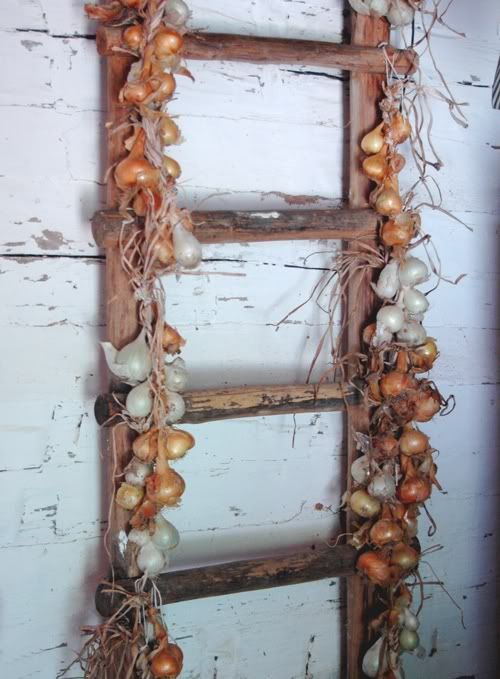
Garden onions, braided, dried and hanging in the kitchen.
Root crops are pulled before the first frost and stored underground in pits lined with straw.
Apple were picked and used to make cider. They were easily stored underground like the root vegetables. They were also peeled and sliced into rings which were dried in the sun. The peelings were used to make vinegar.
The last food preparation task in the fall is to slaughter the hog. It must be done at a certain time, after the first hard frost. The family would have consulted the Farmer's Almanac carefully because if the weather turns warm once again the meat will spoil. If there's extreme cold the meat will freeze before it has a chance to "take" the salt.
The men take the hams, shoulders and jowls to the smokehouse where they will undergo the tradition west Tennessee country cure. The meat is laid on benches which are covered with salt and more salt is poured over the top. The salt draws the moisture out of the meat and it evaporates into the air. After several weeks the meat is washed down and hung from the rafters in the smokehouse. Green hickory chips are burned in a slow fire in the middle of the structure. The meat is left to hang throughout the year.
Sausage is prepared and forced into cloth casings. This is still a tradition in west Tennessee and I bought up every cloth-cased sausage at the Piggly Wiggly in Dover, Tennesse on my way home. If you're never tasted smoke cured meat you're really missing something. The traditional sausage is just divine.
After the pig, from snout to squeak, has been processed and stored, the lard is rendered.
Being a settler was hard work but a well-managed farm meant there would be few lean times.
These farmers were serious about caring for their implements and livestock because it meant their lives.
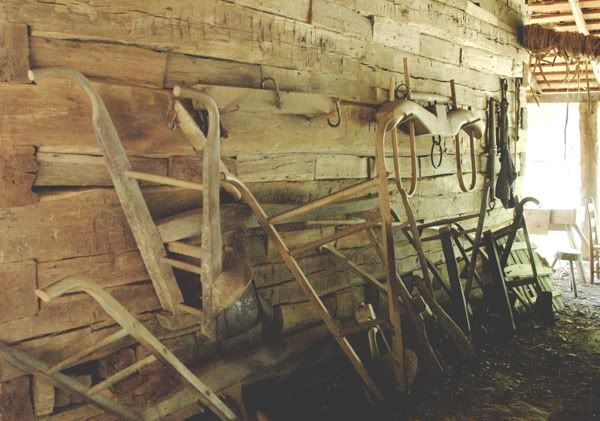
Farm implements stored in a shed.
They had to wear many hats. Here's the bellows for the blacksmithing shed.
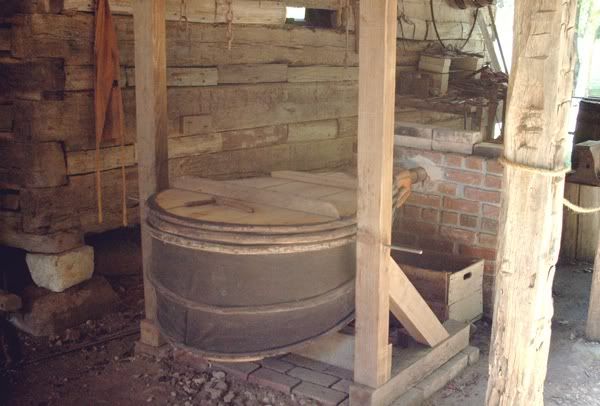
Bellows, made by hand.
These bellows were made by the man I'm going to introduce you to. He works as an interpreter at The Homeplace and his name is John Farrell. His family has lived in this area since the 1700's. This is true of many of the local people in this area of the country. My own family has lived within a 30 mile radius of where our forefather settled in the late 1700's.
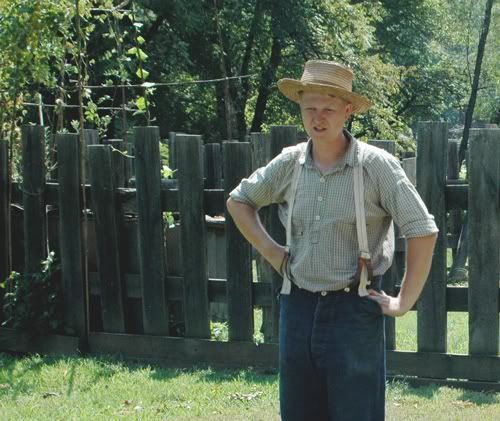
John Farrell - Living history farmer.
John is responsible for the draft animals, including two huge oxen, two equally huge draft horse and a rare palomino mule.
He's a very interesting person and tells lots of stories. Here he's trimming the mane on the palomino mule.
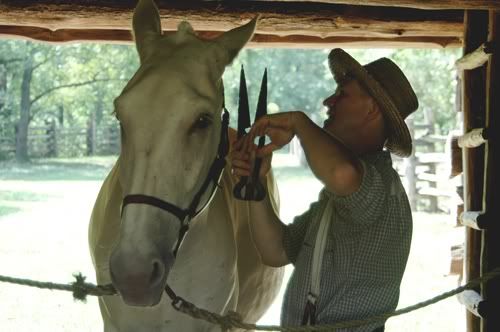
John and the mule.
He is a farrier, shoeing the horses and the mule, although these animals prefer to work the fields "barefoot" as John calls it. Notice the clippers. John built the bellows from scratch, without a pattern, using only photos and descriptions. Like his ancestors he has learned to be resourceful - a real McGuyver!
Here he is with Bob, the draft horse.
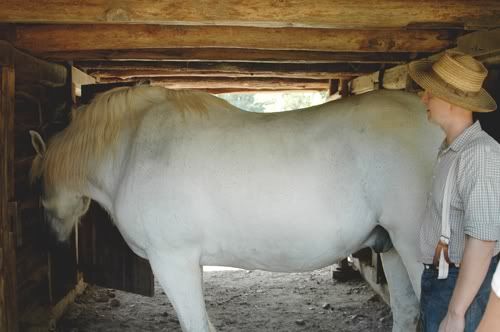
Bob and John.
Notice the low ceiling in the barn. The ceiling was actually raised to accomodate these horses.
The women dye wool and begin spinning and weaving.
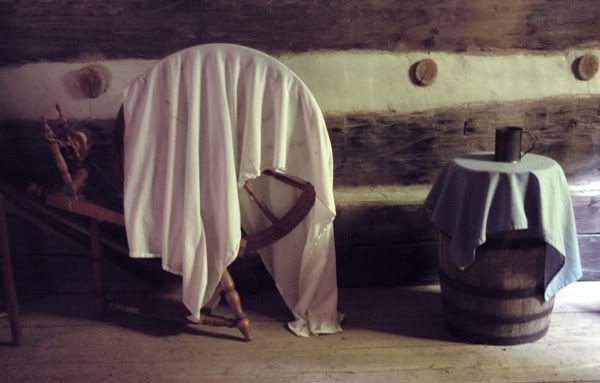
Spinning wheel.
Cloth was labor intensive to produce and so it was a precious commodity.
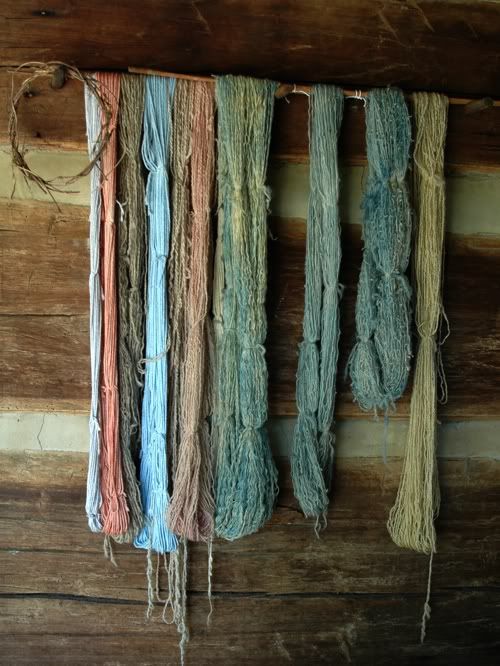
Wool dyed with natural materials.
And so the family prepared for winter, laying down their store of food and a woodshed filled with wood.
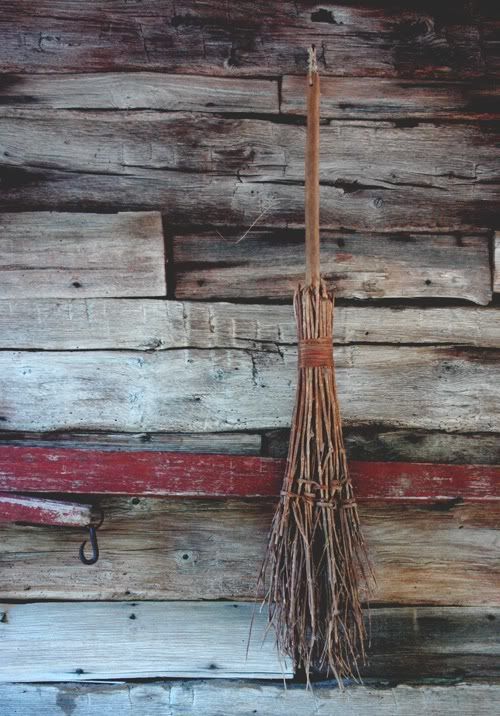
I hope you've enjoyed your visit to The Homeplace 1850. Be sure to visit if you're ever in the area. It's on The Trace. Drive a little further down to Dover and get that wonderful Tennessee sausage in the cloth casing. It's heaven on earth.
Thanks for coming along with me. I hope you enjoy the road trips and the field trip. Please let me know by leaving me a "hey".
Here's one of my favorite fall recipes.
CORN COB JELLY -
12 red corn cobs
2 quarts water
1 package Sure Jel
3 cups sugar
Break cobs into pieces and boil in water for 30 minutes. Remove from heat and strain. Return 3 cups to pan and add Sure Jel. Bring to a rolling boil. Add sugar and boil for 5 minutes or to jelly stage.
Let cool a bit and pour into clean jelly glasses. Seal with paraffin.
NOTE: If you can't get the red cobs you can use regular cobs. Boil, cut the corn off the cob (freeze for later use) and proceed with the recipe.
This is a very delicious jelly. Try it!!






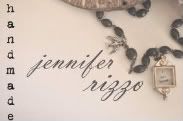




5 comments:
Here is a "Hey" for you. I do love the living history museums. Just shows how good we have it. We went to one in Thunder Bay Canada - above Lake Superior - for our 10th anniversary. I got to pull the bellows - really heavy... and we ate fresh bread and a stew they would have had. Yummy.
Thanks for taking us with you on tour. Terri
Not sure about the jelly...
This has been a fascinating road trip and I would love to have the opportunity to visit this history farm and to eat some real sausuage. I've visited one such working history farm called King's Landing in New Brunswick, Canada. It's great fun, too, and I especially love the bread that they bake and sell daily. There's a working Inn on site and the meals they turn out are beyond belief. Course, no AC so some days are pretty hot and miserable.
As always, some days I know how to spell "sausage" and some days...
Suzanne this has been fascinating. I wouldn't like the difficulty in getting fabric...but then I'm pretty sure sewing wouldn't be a hobby but a necessity! blessings, marlene
I love your field trips!
Post a Comment